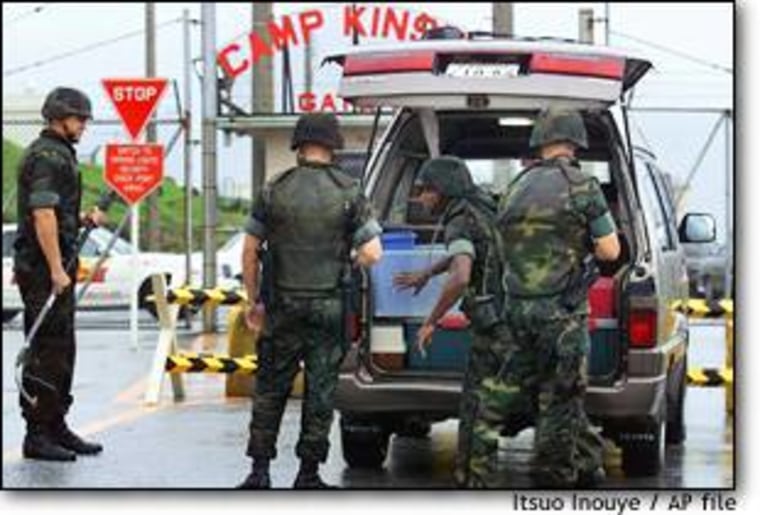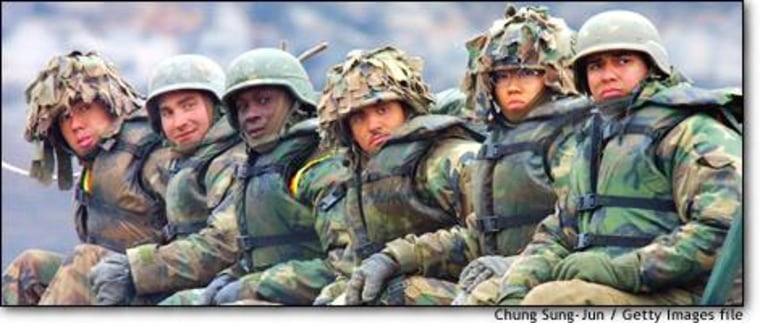In the most sweeping realignment of American military power since World War II, the United States is planning to shift most of its forces from Germany, South Korea and the Japanese island of Okinawa, U.S. and foreign military officials say. The plans, still the focus of intense negotiations and debate among America’s allies and inside the Bush administration, would reorient America’s presence in Europe eastward to Poland, Romania and Bulgaria, and shift U.S. power in the Far East toward southeast Asia, with options for new bases in northern Australia, the Philippines and even Vietnam being explored.
Besides closing military facilities that, in some cases, date to the defeat of Nazi Germany and Imperial Japan in 1945, these officials say the moves being contemplated would have far reaching implications for America’s relationship with leading powers in Europe and Asia. There currently are some 70,000 American troops based in Germany, 38,000 in South Korea and 47,000 in Japan, about 30,000 of which are crammed onto the tiny island of Okinawa. To varying degrees, and for varying reasons, the presence of so many American troops in each place has become increasingly controversial.
“What’s going on is partly a long-overdue adjustment, and partly a reaction to what is perceived as a very ungrateful attitude toward us in some quarters,” says a senior U.S. military officer, requesting anonymity. “None of these places are ideal for American purposes anymore, and I think the time is just right to do it.”
The combination of new threats, the friction U.S. troops are causing domestically in these countries and a desire on the part of the Pentagon to rethink the structure of the military in general, and in particular the U.S. Army, has convinced the Bush administration that a thorough reconfiguration of America’s overseas presence is in order. While some units could be pulled back to the continental United States, officials say most currently are earmarked for redeployment abroad. Together with the recently announced decision to pullout from Saudi Arabia, the scope of the changes being contemplated are unprecedented.
Negotiations and debates
American officials publicly have denied any concrete plans to move specific units or bases from one country to another. But on Friday, Paul Wolfowitz, the influential deputy defense secretary, confirmed that a complete rethink is underway.

“We are in the process of taking a fundamental look at our military posture worldwide, including in the United States,” Wolfowitz told reporters during a visit to Singapore. “We’re facing a very different threat than any one we’ve faced historically.”
Turning American military strategy away from South Korea, Germany and Japan’s island of Okinawa, three places where American troops fought and died over territory, raises enormous questions. Among the most important, where to put the nearly 150,000 troops currently based in those countries.
Currently, according to a senior military officer involved in planning these moves, plans call for shifting most of the forces currently based in Germany into three newly democratic nations: Poland, Romania and Bulgaria. The fact that all three stood by the United States in the run up to the recent war in Iraq certainly doesn’t hurt, the officer says. But other officials, some of whom admitted that they favored the moves to send a message to long-time allies, also confirmed that the gist of the planned draw down in Germany dates back as far as the Clinton administration.
The European moves would likely be in phases, according to these sources, with ground forces and some air units moving first, followed by hospital, support and armored forces — all harder to move — at some later date. One officer suggested that several complex American facilities, such as the Ramstein Air Force Base, might continue to operate, perhaps under NATO auspices.
All three potential host countries already have indicated their willingness to accommodate American forces. In April, the Pentagon announced the sale of F-16 warplanes to Poland at knock down prices, ostensibly as thanks for the work Polish special forces troops did in Iraq, but officials say this is part of an ongoing effort to cement U.S.-Polish ties generally.
U.S. aircraft already are using air fields in both Bulgaria and Romania to keep units in Iraq and Afghanistan supplied, and the governments of both nations — eager to win NATO membership next year — have invited the U.S. to establish permanent bases.
Asia: Reducing exposure
In Asia, the situation is somewhat different. Recent elections in South Korea exposed a deep strain of anti-Americanism that rankled the Bush administration. In Okinawa, the Japanese island that was site of one of World War II’s bloodiest battles, similar feelings have developed over the past decade toward the 30,000 American Marines and soldiers there.
Having led the intervention on behalf of South Korea in 1950, Washington has kept some 38,000 troops in place since the truce that ended combat in 1953. The troops are regarded as a “trip wire” force — in effect, a force large enough to slow but not win a war against the North. With political support for the U.S. presence faltering in the south, many in Washington are wondering about the long term benefits of such an exposed position.
“My reading is that the U.S. forces in Korea need to be redeployed,” says Dr. Melvin Ott, a professor of national security studies at the National War College in Washington. “It’s two things, really: the internal political sensitivities in South Korea, and secondly, a rethinking of how vulnerable you want to be.”
Initially, officials say, the idea was to address South Korean complaints and the vulnerability of forward deployed U.S. forces to North Korean artillery by redeploying them further south down the peninsula. But estimates of the costs involved, officials say, have led many to push for a much larger draw down from Korea, combined with a shift of American forces out of Okinawa, all aimed at creating a larger presence in southeast Asia and along the periphery of China.
“The thinking is that, if you’re saying softly that China and Islamic terrorism are the issues in the long run, then concentrating your forces in Northeast Asia doesn’t make a whole lot of sense,” says Ott.
Basing options in Asia are more limited, however. Northern Australia, a mere 200 miles from the southern islands of Indonesia, is considered the most likely site, though officials confirm that talks for various types of air, sea and ground basing rights are underway with the Philippines and Malaysia, as well. Both, however, seem unlikely hosts to American ground troops.
Even Vietnam is being approached, according to Russian reports. Moscow’s own Pacific Fleet is pulling out of the big port of Can Rahm Bay on July some 25 years after Hanoi invited the Soviet Navy into what was formerly a U.S. Navy base. Now, according to the Novye Izvestia newspaper, Vietnam is in talks with the U.S. to grant landing and port rights on a fee-paying basis.
Uprooting decades of military infrastructure from South Korea, Germany and Okinawa will not be simple, however, either from a physical standpoint or a psychological one. Generations of American soldiers have cycled through such outposts as the sprawling Warner Barracks in Bamberg, Germany, the huge Yonsang Army Garrison in Seoul or the Marines’ Camp Courtney in Okinawa. These facilities and the “Little Americas” that grew up around them to house family members play an underrated role in the relationship between the U.S. and the host nations. Most American men over 40 know someone — a brother, an uncle, a friend — who has spoken kindly of the Germans, Koreans or Japanese they met while serving there.
More seriously, adjusting the posture of the world’s dominant military power invariably will be seen as a threat by those suddenly confronted with the hyperpower on their doorstep.
Russia repeatedly has warned that it takes a dim view of the idea of American bases in Eastern Europe, though since 9/11, when Moscow acceded to the establishment of U.S. bases in former Soviet Central Asia, some of those concerns may have diminished. Interestingly, the issue appeared absent completely from Bush’s discussions with Russian President Vladimir Putin over the weekend.
Asian powers traditionally are a bit more jittery about such things. Already candidates in the Indonesian presidential election next year are citing the potential U.S. presence in Australia as a provocation. Malaysia’s Prime Minister Mahathir Mohamed routinely rails against American hegemony, and in the Philippines, plans for a more potent U.S. role in battling Muslim guerillas there had to be abandoned because of prohibitions in the nation’s constitution against the basing of foreign troops on its soil — a provision that reflects lingering unhappiness with the fact that U.S. troops based troops there for nearly a century until the early 1990s.
More than any other nation, however, China has been watching the situation carefully. Ott and other experts in Asian security studies say that analysts at Chinese defense universities have been chewing over the implications of the planned American troops shifts for some time, though China’s government has been characteristically quiet.
Even in Australia, where attitudes toward the United States are broadly positive, there is concern about how the sudden appearance of large numbers of American troops on Australian soil would affect relations with the country’s neighbors.
“I don’t think it would be a good thing at all and it’s not something we ought to encourage,” Kim Beazley, a former defense minister, told the Australian Broadcasting Company on Friday.
